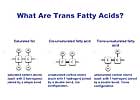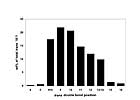
During the past 17 years, there has been a tremendous interest in the nutritional characteristics of trans fatty acids (TFAs). There are two primary reasons for this activity. First, several human feeding studies have consistently observed that TFAs from partially hydrogenated vegetable oils (PHVO), at sufficiently high levels, raise blood LDL-cholesterol (LDL-C) to a similar degree as saturated fatty acids and, unlike saturated fatty acids, which raise plasma HDL-cholesterol (HDL-C), TFAs do not. Second, conjugated linoleic acid (CLA), a form of TFA containing a cis and trans double bond, has been shown to exhibit multiple health-related benefits.
In addition to clinical studies showing the effects of TFAs on plasma LDL-C and HDL-C, several epidemiological studies have reported positive associations between the intake of TFAs and the risk of coronary heart disease (CHD). This effect was primarily accounted for by industrially produced PHVO whereas ruminant derived TFAs were not associated with an increase in CHD risk.
The consistent findings from metabolic and epidemiological studies have resulted in dietary recommendations by government agencies to decrease the intake of TFAs to levels as low as possible while others have recommended TFA intake goals of <1% of total energy intake. In addition, food labeling legislation has been enacted in many countries, including the U.S. and Canada, that require the amount of TFAs to be declared on the nutrition label.

What are Trans Fats?
The fat in foods contains a mixture of saturated, monounsaturated and polyunsaturated fatty acids. In foods of animal origin, a large proportion of fatty acids are saturated. In contrast, in foods of plant origin such as liquid vegetable oils, a large proportion of the fatty acids are monounsaturated (MUFA) and polyunsaturated (PUFA). Trans fat (also known as trans fatty acids) is a specific type of fat formed when liquid oils are made into solid fats like shortening and hard margarine. However, trans fat is also found naturally, primarily in ruminant foods including dairy and beef products. Ruminant milk and fat products provide smaller quantities of trans fat, which result from partial biohydrogenation of feed MUFA and PUFA by rumen bacteria. FDA estimates that the average daily intake of trans fat in the U.S. population is about 5.8 grams or 2.6% of calories per day for individuals 20 years of age and older.Industrially produced trans fat is made when hydrogen is added to vegetable oil - a process called hydrogenation. Hydrogenation increases the shelf life and flavor stability of foods containing these fats. In most unsaturated fatty acids the hydrogen atoms at a double bond are positioned on the same side of the carbon chain, a position called the cis-configuration (Latin, on this side). However, partial hydrogenation of vegetable oils reconfigures some double bonds of unsaturated fatty acids and the hydrogen atoms end up on different sides of the chain. This type of configuration is called “trans” (“across” in Latin) (Figure 1).

Ruminant vs. Industrial Trans Fats and Coronary Heart Disease Risk
The TFA levels of PHVO vary widely and may account for up to 60% of the total fatty acid content, whereas the levels in dairy and beef fats is considerably lower, accounting for 3 – 6% of total fatty acids. By comparison, the CLA content of milk fat may vary from 0.2 – 2.2%. In 2003 – 2004, the level of CLA found in U.S. milk fat averaged about 0.5%. The levels of TFAs in milk fat can vary markedly by geographic region and seasonal changes in diet.In industrial-produced trans fats, the predominant monounsaturated TFA formed is elaidic acid (9 trans-18:1) with significant quantities of other TFA isomers (i.e. 10 trans 18:1, 6-8 trans-18:1, 11 trans-18:1, and trans 12-18:1) (Figure 2a). In ruminant fat, the predominant monounsaturated TFA is trans vaccenic acid (11 trans-18:1), which can account for more than 60% of the TFA content of bovine milk fat (Figure 2b). Hence, although the types of monounsaturated TFAs contained in industrial-produced trans fats and ruminant fats are largely the same, there is considerable differences in the levels of the individual monounsaturated TFAs. In addition, ruminant fats contain significant amounts of CLA (i.e. predominantly 9 cis, 11 trans-18:2, also termed rumenic acid), whereas PHVO is virtually devoid of CLA. There is, therefore, a basis for potential metabolic differences between industrial and ruminant trans fats that may be related to specific TFAs, their levels and differences in how they are metabolized in the body. For example, one major difference between PHVO and ruminant TFAs is that unlike elaidic acid, the major TFA in PHVO, trans vaccenic acid can be bioconverted to rumenic acid by ruminants as well as non-ruminants, including humans. In humans, the estimated conversion of trans vaccenic to rumenic acid ranges from 19 – 24%. Furthermore, unlike clinical studies with PHVO which have consistently demonstrated that TFAs from PHVO raise LDL-C to a similar degree as saturated fat, clinical studies with diets enriched in rumenic acid (cis-9, trans-11 18:2) or diets enriched in rumenic + trans vaccenic acid did not show any significant effect on plasma LDL-C, HDL-C or triglyceride levels. Additionally, epidemiological studies that have evaluated the effect of TFA from PHVO and ruminant fat sources on the risk of CHD suggest that the strength of a direct association is mainly supported by trans fat from partially hydrogenated vegetable oils and not the trans fat from ruminant dairy and meat fat. Clearly, additional clinical research is needed to determine whether the intake of ruminant trans fat and especially trans-vaccenic acid is similar or different from industrial sources of trans fat with respect to the impact on coronary heart disease risk.
Regulatory Environment
In 2003, the FDA issued a final rule requiring TFAs to be declared in the Nutrition Facts panel as a separate line item of all conventional foods and dietary supplements that contain 0.5 g or more TFAs per serving. The mandatory listing of the trans fat content on food labels became effective January 1, 2006. Under FDA’s regulatory chemical definition for trans fatty acids, which includes all unsaturated fatty acids that contain one or more isolated (i.e., nonconjugated) double bonds in a trans configuration, conjugated fatty acids including CLA would be excluded from the definition of trans fat. The FDA noted in its ruling on trans fatty acid nutrition labeling that for the purpose of this rule, the origin of the TFAs does not matter. Trans vaccenic acid and other TFAs of ruminant origin with either a single double bond or nonconjugated double bonds are included in the chemical definition of TFAs.For most dairy products including whole milk, butter, full fat natural and processed cheeses, and ice cream frozen desserts, the level of trans fat does not exceed the 0.5 g threshold per reference serving and, hence, can be declared as “zero” trans fat in the Nutrition Facts panel (i.e. trans fat 0 g). On the other hand, some dairy-based products formulated with dairy ingredients (e.g. butter, cream cheese, etc.) and possibly containing additional industrial sources of trans fat may exceed the 0.5 g threshold per serving and require declaration of the grams of trans fat on the label.
In addition to the federal rules on trans fat labeling of retail food products, local city governments have enacted ordinances that prohibit products containing industrial trans fats to be served by food service establishments. In some cases, a lack of clear distinction between natural and industrial trans fat have negatively impacted the allowance of dairy-based products that contain both types of trans fats.
In other countries, different approaches have been used for managing the intake of trans fat and/or declaring trans fat on the nutrition label. For example, in Canada, food products that contain 0.2 g or more of trans fatty acids per reference amount and per serving are required to declare the level of trans fat on the label. Like the U.S., the Canadian trans fat definition excludes conjugated fatty acid (i.e. CLA) and includes all nonconjugated TFAs including ruminant sources (i.e. trans vaccenic acid). Whole milk, butter, full fat natural and processed cheeses, and ice cream frozen desserts exceed the 0.2 g threshold per reference serving and, hence, require the declaration of trans fat in the Nutrition Facts panel.
In Denmark, in 2003, in response to recommendations from the Danish Nutrition Council, the Danish government issued an order that prohibited the use in foods, oils containing more than 2% of industrially produced trans fat by 2004. The order does not apply to naturally occurring TFAs in animal fats or dairy products. Recent analyses of foods that have traditionally been significant sources of industrially produced trans fats clearly demonstrate that these trans fats have been virtually eliminated from foods in Denmark.
